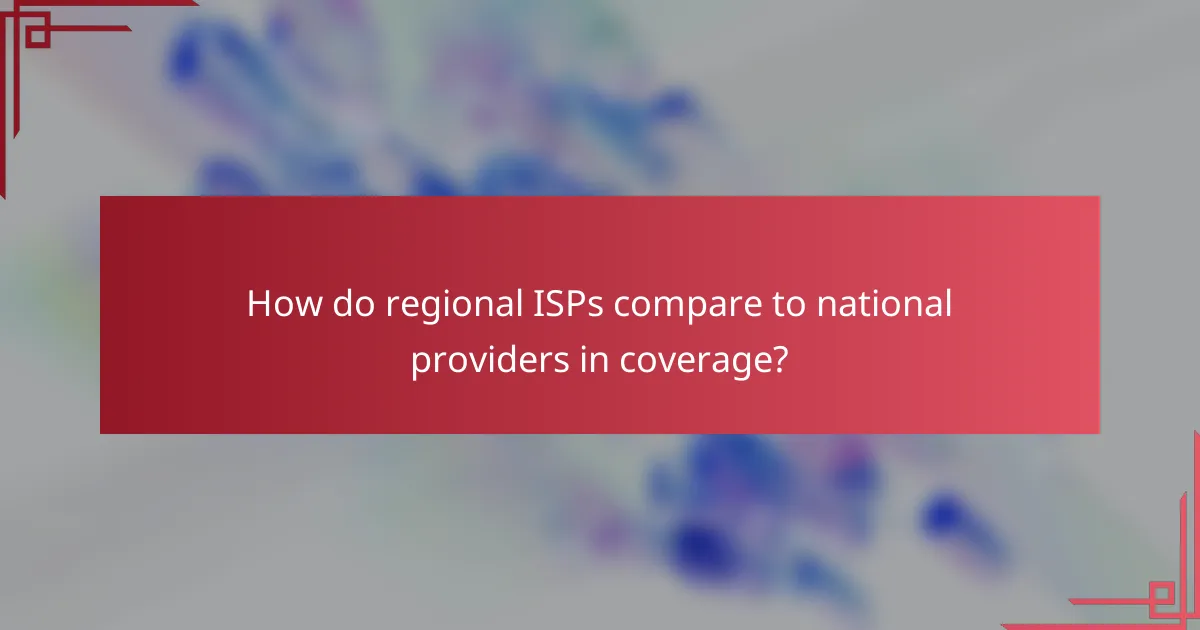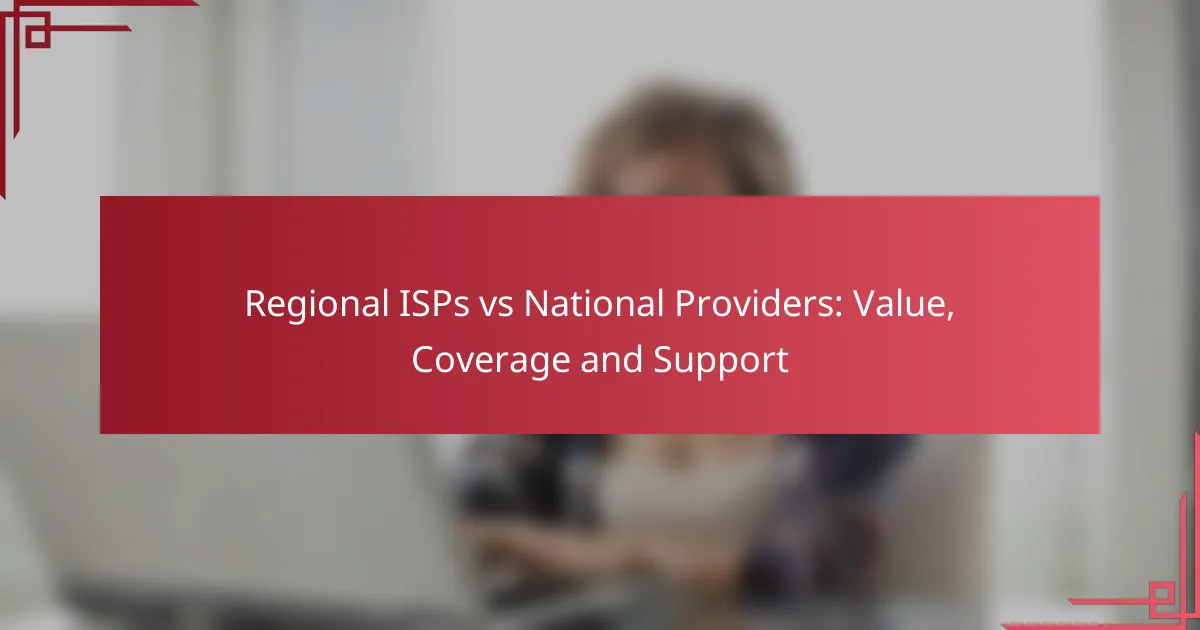When choosing between regional ISPs and national providers, consumers must weigh the benefits of personalized service and local expertise against the extensive coverage and advanced infrastructure offered by larger companies. Regional ISPs often cater to the unique needs of their communities, providing tailored services and competitive pricing. In contrast, national providers deliver consistent service quality and broader access, making them appealing for users in need of reliable internet across various regions.

What are the advantages of regional ISPs in the US?
Regional ISPs in the US offer several advantages, including personalized customer service, tailored services for local communities, and competitive pricing. These providers often focus on specific areas, allowing them to meet the unique needs of their customers more effectively than larger national providers.
Localized customer support
Regional ISPs typically provide localized customer support, which means that their representatives are often familiar with the specific challenges and needs of the community. This can lead to more effective problem-solving and a better overall customer experience.
For example, if a service outage occurs, local support teams can respond more quickly and understand the geographical factors that may be affecting service. This level of familiarity can result in higher customer satisfaction compared to national providers.
Community-focused services
Regional ISPs often develop services that cater specifically to the needs of their local communities. This can include specialized packages for small businesses, educational institutions, or even local events. By focusing on community needs, these ISPs can create value that larger companies may overlook.
For instance, a regional ISP might offer discounted rates for local schools or provide sponsorship for community events, fostering a sense of connection and loyalty among customers.
Faster response times
With a smaller customer base and localized operations, regional ISPs can often achieve faster response times for service issues. Customers may find that they can reach a support representative quickly and receive assistance without long wait times.
This efficiency is particularly beneficial during service outages or technical difficulties, where timely support can minimize disruption. Many regional ISPs pride themselves on resolving issues within hours, compared to the longer wait times that can be common with national providers.
Flexible pricing options
Regional ISPs frequently offer flexible pricing options that can be more accommodating than those of national providers. This may include tiered pricing plans, discounts for long-term contracts, or customized packages based on specific usage needs.
For example, a regional ISP might provide a basic plan for low internet usage at a lower price, while also offering higher-speed options for users who require more bandwidth. This flexibility allows customers to choose plans that best fit their budget and usage patterns.

What are the benefits of national internet providers?
National internet providers offer extensive advantages, including broader coverage, advanced infrastructure, and consistent service quality. These benefits make them a strong choice for users seeking reliable internet access across various regions.
Wider coverage across the US
National internet providers typically have a vast network that spans urban and rural areas alike, ensuring that more customers can access their services. This extensive coverage means that even in less populated regions, users are more likely to find a reliable connection.
For example, major providers like Comcast and AT&T can reach millions of households, while regional ISPs may only serve specific towns or cities. This broad reach can be crucial for families or businesses that move or expand into new areas.
More robust infrastructure
National providers invest significantly in their infrastructure, which often includes advanced fiber-optic networks and extensive data centers. This investment results in faster speeds and improved reliability compared to many regional ISPs.
For instance, a national provider may offer gigabit speeds in many areas, while a local ISP might only provide slower DSL connections. The difference in infrastructure can directly impact user experience, especially for bandwidth-intensive activities like streaming or gaming.
Consistent service quality
With a larger operational scale, national internet providers can maintain a more consistent level of service quality across their coverage areas. This consistency is often reflected in lower downtime and faster response times for customer support.
Customers can expect similar performance whether they are in New York or California, which is not always the case with regional providers that may struggle with service reliability in certain locations.
Bundled services available
Many national internet providers offer bundled services that include internet, television, and phone options. These bundles can provide significant savings compared to purchasing each service separately from different providers.
For example, a customer might find that bundling their internet with cable TV and home phone service can lower their total monthly bill by a noticeable percentage. This convenience and potential cost-saving make national providers appealing for households looking to simplify their service management.

How do regional ISPs compare to national providers in coverage?
Regional ISPs typically offer more localized coverage, which can be beneficial for specific communities, while national providers have extensive networks that span larger areas. The choice between them often depends on the specific needs for internet access, including speed, reliability, and customer support.
Regional coverage limitations
Regional ISPs often have limited service areas, focusing on specific towns or regions. This can result in gaps in coverage, especially in less populated or remote areas. Customers may find that while they receive personalized service, their options for high-speed internet are restricted compared to national providers.
Additionally, regional ISPs may not have the infrastructure to support the latest technologies, such as fiber-optic connections, which can limit internet speeds and reliability. Users should consider whether the ISP can meet their bandwidth needs before committing to a service plan.
National provider service areas
National providers typically cover vast geographic areas, making their services available in many urban and suburban regions. This extensive reach allows them to offer competitive pricing and a variety of plans to suit different user needs. However, the quality of service can vary significantly depending on the specific location.
While national ISPs may provide more comprehensive coverage, they can sometimes lack the personalized customer support that regional ISPs offer. Customers should weigh the benefits of extensive coverage against the potential for less tailored service.
Availability in urban vs rural areas
In urban areas, both regional ISPs and national providers often compete for customers, leading to a wider selection of plans and potentially better pricing. Urban customers may benefit from higher speeds and more advanced technology options due to the dense infrastructure.
Conversely, rural areas may face challenges with both types of providers. Regional ISPs might be the only option in some rural locations, but their service may be limited. National providers may offer coverage but often at lower speeds and higher latency due to the distance from their infrastructure. Users in rural areas should investigate local options thoroughly to find the best service available.

What factors should you consider when choosing an ISP?
When choosing an Internet Service Provider (ISP), consider pricing, customer service, internet speed, and data policies. Each factor can significantly impact your overall experience and satisfaction with the service.
Pricing and contract terms
Pricing varies widely between regional ISPs and national providers. Regional ISPs often offer competitive rates, while national providers may have bundled services that can save you money in the long run. Look for hidden fees, installation costs, and the length of contracts when comparing options.
Common contract terms include month-to-month agreements or fixed-term contracts lasting one to two years. Be cautious of early termination fees, which can add to your overall costs if you decide to switch providers before your contract ends.
Customer service reputation
Customer service is crucial when choosing an ISP, as issues with your connection can arise unexpectedly. Regional ISPs may provide more personalized service, while national providers often have larger support teams but can be less responsive. Research customer reviews and ratings to gauge the reliability of support services.
Consider the availability of support channels, such as phone, chat, or email, and the average wait times for assistance. A provider with a strong customer service reputation can save you time and frustration in the long run.
Internet speed and reliability
Internet speed and reliability are vital factors in your ISP choice. Check the maximum speeds offered by different providers, which can range from a few Mbps to several Gbps. Ensure that the speeds meet your household needs, especially if multiple users will be streaming or gaming simultaneously.
Reliability is equally important; look for ISPs with a proven track record of minimal downtime. Research local outage history and ask neighbors about their experiences to get a clearer picture of what to expect.
Data caps and throttling policies
Data caps limit the amount of data you can use each month, which can be a significant concern for heavy internet users. Some ISPs impose strict data limits, while others offer unlimited plans. Review the policies of potential providers to avoid unexpected charges or throttled speeds once you exceed your limit.
Throttling occurs when an ISP intentionally slows down your internet speed after you reach a certain data threshold. Understanding these policies can help you choose a provider that aligns with your internet usage habits and avoid interruptions in service.

How do regional ISPs support local communities?
Regional ISPs often play a crucial role in supporting local communities by providing tailored services, fostering local events, and enhancing digital access. They prioritize community needs and invest in local initiatives, which can lead to stronger connections and improved services for residents.
Sponsorship of local events
Regional ISPs frequently sponsor local events, such as festivals, sports tournaments, and educational programs, which helps to strengthen community ties. By providing financial support or resources, these ISPs not only promote their brand but also contribute to the cultural and social fabric of the area.
For example, a regional ISP might sponsor a local high school sports team, providing uniforms and equipment. This not only boosts the team’s visibility but also encourages community members to engage with the ISP, fostering loyalty and trust.
When considering an ISP, look for those that actively participate in local sponsorships. This involvement can indicate a commitment to the community and may lead to better customer service and support tailored to local needs.



